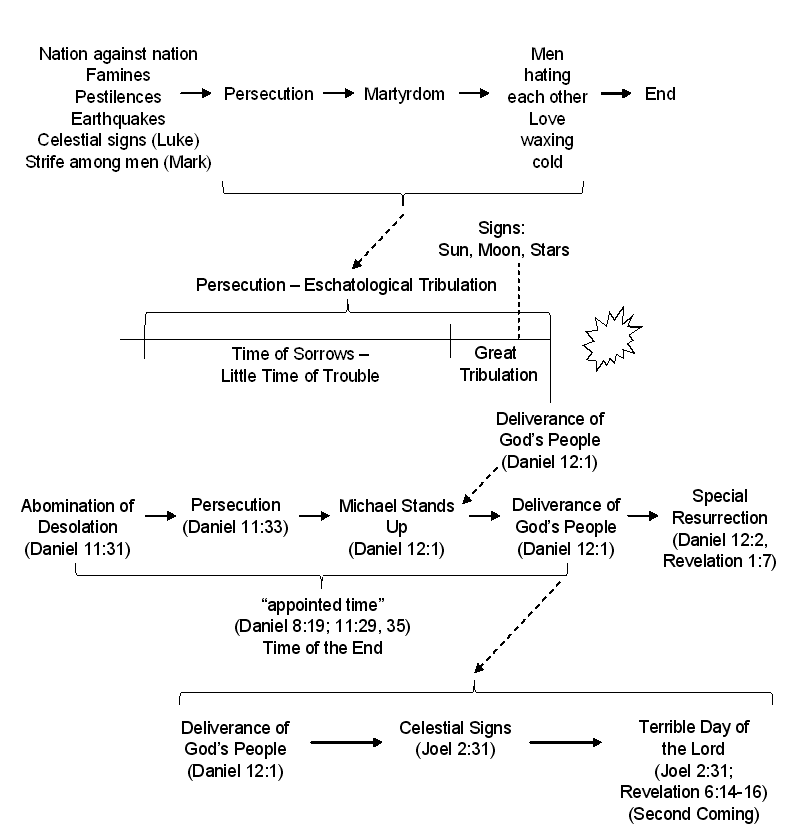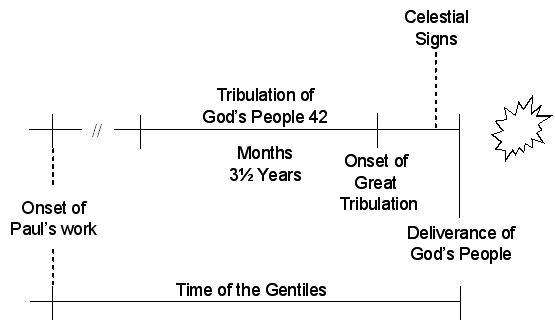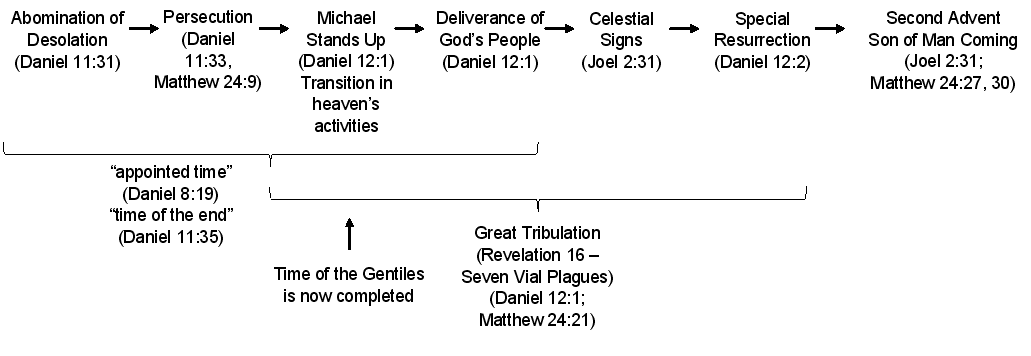[for PDF click here]
(Olivet Discourse – Luke 21:24)
Part 7
Introduction
We digress initially to look at the sequences thus far developed in our study.
God’s people have an escape message: “Flee!” For those who don’t heed Christ’s warning comes these fearful words:
“And they shall fall by the edge of the sword, and shall be led away captive into all nations: and Jerusalem shall be trodden down of the Gentiles, until the times of the Gentiles be fulfilled” (Luke 21:24).
As previously mentioned, Luke’s narrative is more focused on Jerusalem’s literal fall, whereas Matthew 24 leans towards the time of the Second Advent. The transition events to the advent in both applications describe the tribulation horrors. Luke notes:
- Great distress in the land (21:23), alluding to Judea.[1]
- God’s wrath against His people (the apostate Jews) (21:23).
- There is no narrative suggesting a shortening of the persecution (as in Matthew).
- Fall by the edge of the sword (cf. Jeremiah 20:4-6, 21:7)
- Led away captive (cf. Romans 7:23, II Corinthians 10:5, II Timothy 3:6).
- Jerusalem will be trodden down (10:19) (Zechariah 12:3; Daniel 8:10, 13; Isaiah 63:18; Psalm 79:6; Revelation 11:2).
This tribulation period describes one of Gentile war and violence on the literal city of Jerusalem. But – it is also used as a metaphor for an end-of-time time of trouble.
When does that “Gentile” time begin? Paul gives us insight in Romans:
-
“… rather through their fall [Jewish apostasy] salvation is come unto the Gentiles, for to provoke them to jealousy” (Romans 11:11b).
Since the fall of the Jewish nation, the opportunity for salvation for the Gentiles has been opened. It became their “time.” - “I [Paul] am the apostle of the Gentiles” (Romans 11:13b).
- “For I would not, brethren, that ye should be ignorant of this mystery, lest ye should be wise in your own conceits; that blindness in part is happened to Israel, until the fulness of the Gentiles be come in” (Romans 11:25). At the end, everything regarding God’s chosen people will become clear!
When the word “mystery” is used, it normally refers to the end of time in Jewish apocalyptic thinking.[2]
Here, and in I Corinthians 15:51, it refers to the “end of history.”
- The “time of the Gentiles” transcends the devastation of Jerusalem’s fall – and
- Extends to the eschatological end!
When the time of the Gentiles is fulfilled, this follows [part of Luke’s sequence]:
“And there shall be signs in the sun, and in the moon, and in the stars” (Luke 21:25a).
- We suddenly return to the familiar celestial signs noted by Matthew (24:29).
- If Matthew’s sequence is preserved, then the “great tribulation” should be associated with the Second Coming.
That is exactly what is seen.
- “And upon the earth distress of nations, with perplexity … Men’s hearts failing them for fear, and for looking after those things which are coming on the earth: for the powers of heaven shall be shaken. And then shall they see the Son of man coming in a cloud with power and great glory” (Luke 21:25b-27; cf. Isaiah 57:20-21).
- We are once again reminded of the prophecy under Seal Six:
“And the stars of heaven fell unto the earth, even as a fig tree casteth her untimely figs, when she is shaken of a mighty wind. And the heaven departed as a scroll when it is rolled together; and every mountain and island were moved out of their places” (Revelation 6:13-14; cf. Isaiah 34:4). They all refer to the same time and events.
Paul also portrays this time:
- “Whose voice then shook the earth: but now he hath promised, saying, Yet once more I shake not the earth only, but also heaven” (Hebrews 12:26).
“It is of no little consequence that, especially when read against the background of their OT precursors, these images portend the advent of the Day of the Lord and, so, portray the coming of the Son of Man as a theophany.”[3]
Graphically: [see PDF for proper graphics]

Time of the Gentiles – Looking Deeper
The word “Gentiles” had many meanings to the Hebrew people. In its wider use, it referred to non-Jewish nations or peoples.
- This thinking came especially into focus as the Israelites realized their nationhood at Mount Sinai (Exodus 19:6).
- The “other nations” were seen as being apart from them (Exodus 34:10, Leviticus 18:24-25, Deuteronomy 15:6). Even the mixed multitude were placed outside the organized “camp” till the third generation.
- God would bless Israel, but those “other nations” would be blessed through them (Deuteronomy 28:1-14).
That nation chosen out of all others to bless mankind finds responsive echoes throughout the Old Testament (I Kings 8:41-43; Isaiah 19:24-25; Jeremiah 4:2; Zechariah 8:13, 9:9-10).[4]
- But the allurements of the Gentiles led to the Jewish nation disavowing the covenant promises.
- This blurred and eventually destroyed the Jewish “peculiar people’s” mission.
When Christ came as the Messiah, He revealed that the redemptive purposes extended to all.
- Prophecy had noted that the Gentiles would also be seeking the Lord (Isaiah 11:10; Malachi 1:11; Isaiah 42:6, 49:6; Zechariah 9:9-10).
- The mission of the “seventy” (Luke 10:1) was to the “nations.”
- Jesus would bring peace to the “nations” (Matthew 21:5).
Jesus commissioned the disciples to:
- “Go ye therefore, and teach all nations, baptizing them in the name of the Father, and of the Son, and of the Holy Ghost: Teaching them to observe all things whatsoever I have commanded you: and, lo, I am with you alway, even unto the end of the world. Amen” (Matthew 28:19-20).
- “But ye shall receive power, after that the Holy Ghost is come upon you: and ye shall be witnesses unto me both in Jerusalem, and in all Judaea, and in Samaria, and unto the uttermost part of the earth” (Acts 1:8).
- The greater mission was to the uttermost parts of the earth – the Gentiles.
- It wouldn’t be until then, and only then, that the end could come (Mark 13:10).
This inclusiveness led Paul to include in his Galatian letter:
- “There is neither Jew nor Greek, there is neither bond nor free, there is neither male nor female: for ye are all one in Christ Jesus. And if ye be Christ’s, then are ye Abraham’s seed, and heirs according to the promise” (Galatians 3:28-29).
The “time of the Gentiles” extends to the end of God’s people being “trodden underfoot” (Revelation 11:3). Then Luke’s prophecy would be fulfilled.
- The Jewish people created an outer court in their sanctuary, which was where Gentiles could come, segregated from the worship experience of the inner court.
- It was there that Jesus met with Greeks who told Philip, “We would see Jesus” (John 12:21).
- When the Jewish nation was finally rejected by heaven, the gospel of Jesus went with fervor to the Gentiles!
The “Gentile” imagery changes in John’s apocalyptic book
- The word “Gentiles” becomes a label for the wicked.
- “But the court which is without the temple leave out, and measure it not; for it is given unto the Gentiles: and the holy city shall they tread under foot forty and two months” (Revelation 11:2).
- It was to be excluded in the “measuring” [judging] of the temple (its body, worshipers and leaders) (Revelation 11:1).
The distinction between judgment of the “living church” and the Gentile area reveals that God made a distinction between the wicked and those who claim His saving grace (cf. Revelation 2:9-10, 3:9).[5]
- Divine permission to persecute God’s people (those in the temple) for 42 months links many other apocalyptic prophecies to this (cf. Revelation 13:5).
- Intriguingly (though not part of this study) the sea beast (Revelation 13) and the little horn of Daniel 8 are categorized through exegetic ties to those in the outer court.
- “And it waxed great, even to the host of heaven; and it cast down some of the host and of the stars to the ground, and stamped upon them…. Then I heard one saint speaking, and another saint said unto that certain saint which spake, How long shall be the vision concerning the daily [sacrifice], and the transgression of desolation, to give both the sanctuary and the host to be trodden under foot?” (Daniel 8:10, 13).
This means that for a time God’s people will be subject to the hatred and revenge of the “Gentiles.” That parallels Christ being delivered into the hand of sinners (Mark 9:31).[6]
- However, their witness will be victorious during this same period (Revelation 11:5-6).
- “And I will give power unto my two witnesses, and they shall prophesy a thousand two hundred and threescore days, clothed in sackcloth” (Revelation 11:3).
The time of the Gentiles began formally when the apostles, especially Paul, started their global mission, and ends when this 42-month period is completed.
- The Gentiles are portrayed as the wicked, especially “Christians” in terminal apostasy (the antichrist imagery with his followers).
- This 42-month period is “concentrated persecution time” that precedes the eschaton.[7]
During this last phase, the measuring of God’s “temple people” sets the stage for the final sealing of the saints (Revelation 7:2-8). Those of the outer court reflect the wicked.[8]
- “Therefore no one will assign you land in the Lord’s community.” (Micah 2:5 – NET).
- They will not be protected from God’s judicial wrath nor inherit the “land” of Canaan.
Summation Thoughts
“The disciples were not endowed with the courage and fortitude of the martyrs until such grace was needed. Then the Saviour’s promise was fulfilled. When Peter and John testified before the Sanhedrin council, men ‘marveled; and they took knowledge of them, that they had been with Jesus.’ Acts 4:13. Of Stephen it is written that ‘all that sat in the council, looking steadfastly on him, saw his face as it had been the face of an angel.’ Men ‘were not able to resist the wisdom and the spirit by which he spake.’ Acts 6:15, 10. And Paul, writing of his own trial at the court of the Caesars, says, ‘At my first defense no one took my part, but all forsook me…. But the Lord stood by me, and strengthened me; that through me the message might be fully proclaimed, and that all the Gentiles might hear: and I was delivered out of the mouth of the lion.’ 2 Timothy 4:16, 17, R. V.”[9]
“If ye continue in the faith grounded and settled, and be not moved away from the hope of the gospel, which ye have heard, and which was preached to every creature which is under heaven; whereof I Paul am made a minister; … To whom God would make known what is the riches of the glory of this mystery among the Gentiles; which is Christ in you, the hope of glory.” (Colossians 1:23, 27).
We are in the “time of the Gentiles.” As the “appointed time” comes to a close, that period will be completed or fulfilled. It will be then that Christ’s Olivet prophecy terminates and the “end” comes (Matthew 24:14).
“The gospel invitation is to be given to all the world,—‘to every nation, and kindred, and tongue, and people.’ The last message of warning and mercy is to lighten the whole earth with its glory. It is to reach all classes of men, rich and poor, high and low. As surely as this message shall be proclaimed in all the earth, so surely shall be fulfilled the prophecy given through Malachi: ‘From the rising of the sun, even unto the going down of the same, my name shall be great among the Gentiles; and in every place incense shall be offered unto my name, and a pure offering: for my name shall be great among the heathen, saith the Lord of hosts.’”[10]
Summation graph:
Prophecy Research Initiative – non-profit 501(c)3 © 2012
EndTime Issues…, Number 146, November 1, 2012
